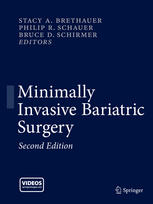

Most ebook files are in PDF format, so you can easily read them using various software such as Foxit Reader or directly on the Google Chrome browser.
Some ebook files are released by publishers in other formats such as .awz, .mobi, .epub, .fb2, etc. You may need to install specific software to read these formats on mobile/PC, such as Calibre.
Please read the tutorial at this link: https://ebookbell.com/faq
We offer FREE conversion to the popular formats you request; however, this may take some time. Therefore, right after payment, please email us, and we will try to provide the service as quickly as possible.
For some exceptional file formats or broken links (if any), please refrain from opening any disputes. Instead, email us first, and we will try to assist within a maximum of 6 hours.
EbookBell Team

5.0
68 reviewsThe second edition of Minimally Invasive Bariatric Surgery provides a comprehensive, state-of-the art review of this field, and it serves as a valuable resource for clinicians, surgeons and researchers with an interest in minimally invasive bariatric surgery. Additionally, the second edition includes new features that will benefit the resident, fellow, or bariatric surgeon new to the field. Specifically, each evidence-based chapter (i.e. outcomes, complications, epidemiology, etc) concludes with three or four exam questions that emphasize the salient points of the chapter and provide fellowship programs a valuable training tool and resource for their academic curriculum. These questions are either single-answer multiple choice or true/false format and the correct response with a brief explanation follows. As more emphasis is placed on completing a comprehensive curriculum and obtaining certification for bariatric training, this aspect of the book is unique and provides added value to the text. The new edition also incorporates many new or updated medical illustrations to enhance the technique chapters and provide more uniformity for the artwork throughout the book. Each of the major procedures include surgical technique, outcomes, and management of complications in separate chapters to provide an easy reference for the busy clinician preparing for a case or presentation. Another unique feature of the text is a link to video files hosted online for the relevant chapters. This video library will be of great value to the user. As the number of fellowships in laparoscopic bariatric surgery continues to increase, this updated text will provide a valuable resource for general and bariatric surgeons, laparoscopic surgeons, fellows, residents, medical students, obesity researchers, and industry representatives involved in this field.